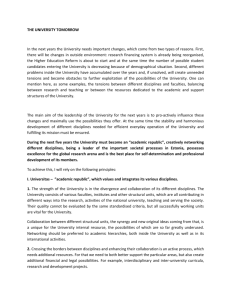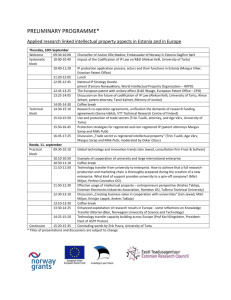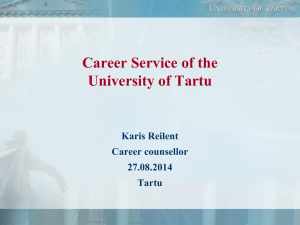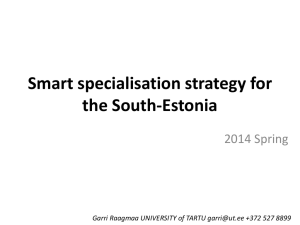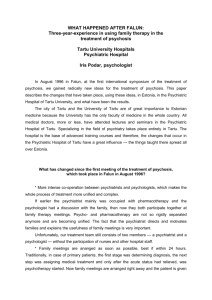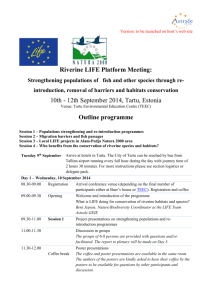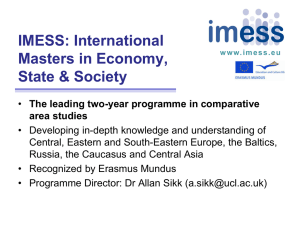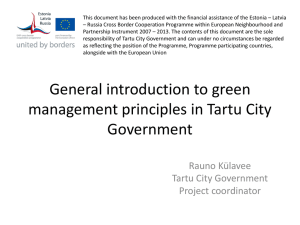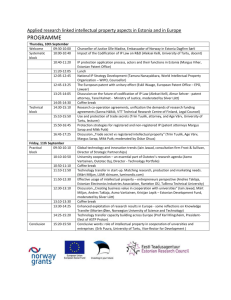Estonian University of Life Sciences
advertisement
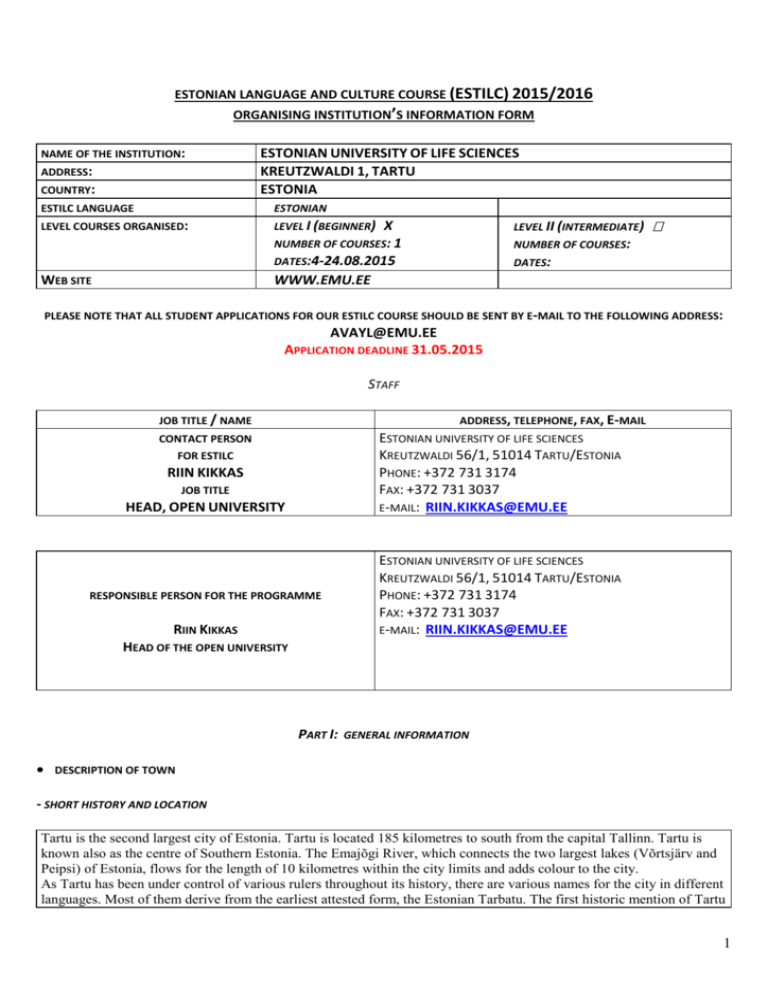
ESTONIAN LANGUAGE AND CULTURE COURSE (ESTILC) 2015/2016 ORGANISING INSTITUTION’S INFORMATION FORM NAME OF THE INSTITUTION: ADDRESS: COUNTRY: ESTONIAN UNIVERSITY OF LIFE SCIENCES KREUTZWALDI 1, TARTU ESTONIA ESTILC LANGUAGE ESTONIAN LEVEL COURSES ORGANISED: LEVEL I (BEGINNER) WEB SITE X NUMBER OF COURSES: 1 DATES:4-24.08.2015 WWW.EMU.EE LEVEL II (INTERMEDIATE) NUMBER OF COURSES: DATES: PLEASE NOTE THAT ALL STUDENT APPLICATIONS FOR OUR ESTILC COURSE SHOULD BE SENT BY E-MAIL TO THE FOLLOWING ADDRESS: AVAYL@EMU.EE APPLICATION DEADLINE 31.05.2015 STAFF JOB TITLE / NAME ADDRESS, TELEPHONE, FAX, E-MAIL ESTONIAN UNIVERSITY OF LIFE SCIENCES KREUTZWALDI 56/1, 51014 TARTU/ESTONIA PHONE: +372 731 3174 FAX: +372 731 3037 E-MAIL: RIIN.KIKKAS@EMU.EE CONTACT PERSON FOR ESTILC RIIN KIKKAS JOB TITLE HEAD, OPEN UNIVERSITY RESPONSIBLE PERSON FOR THE PROGRAMME RIIN KIKKAS ESTONIAN UNIVERSITY OF LIFE SCIENCES KREUTZWALDI 56/1, 51014 TARTU/ESTONIA PHONE: +372 731 3174 FAX: +372 731 3037 E-MAIL: RIIN.KIKKAS@EMU.EE HEAD OF THE OPEN UNIVERSITY PART I: GENERAL INFORMATION DESCRIPTION OF TOWN - SHORT HISTORY AND LOCATION Tartu is the second largest city of Estonia. Tartu is located 185 kilometres to south from the capital Tallinn. Tartu is known also as the centre of Southern Estonia. The Emajõgi River, which connects the two largest lakes (Võrtsjärv and Peipsi) of Estonia, flows for the length of 10 kilometres within the city limits and adds colour to the city. As Tartu has been under control of various rulers throughout its history, there are various names for the city in different languages. Most of them derive from the earliest attested form, the Estonian Tarbatu. The first historic mention of Tartu 1 dates back to 1030, so the city has a lot of history to explore. From the 13th to the 16th century, the town was a prosperous member of the Hanseatic League. Then held in turn by Poles (1582–1600, 1603–25) and Swedes (1600–03, 1625–1704), it was finally annexed to Russia by Peter I the Great in 1704. The city was devastated by fire in 1775 and was largely rebuilt in classical style. After the II World War, Tartu was declared a "closed town" to foreigners, as an air base for bombers was constructed on Raadi Airfield, in the northeast outskirts of the city. The asphalt runway there now houses a large used cars market, and is used for car racing. Citizens and visitors of Tartu will enjoy access to almost 40 museums and galleries and a many concert halls. Tartu has many parks, walking and biking paths and is graced with the Emajõgi River, which flows through the city centre. Tartu in known as capital city of education and student’s city. The population of around 100,000 people, and a fifth of its citizens are students of higher education. The big number of young citizens is a peculiarity of Tartu - almost half of the citizens are under 35 years of age. You will notice that when walking in the streets of Tartu. Large student population means that it has a comparatively thriving nightlife, with many bars, restaurants, and nightclubs. There is always something fun going on in Tartu: As befits a true university town, student life is bustling in Tartu. Perhaps you will encounter the "Tartu Ghost" – a mysterious being that makes you spend too much time and come back to Tartu over and over again. Where does the Ghost live? Nobody knows, but you can feel its presence almost everywhere- in the city district Supilinn, ("Soup Town"), on Toome Hill, in the cosy little cafeterias and in the University. Local people also say that time flows slower in Tartu that’s why Tartu’s slogan is called City of Good Thoughts. - MAIN LOCAL/CULTURAL EVENTS Tartu is a city of festivals, song festivals and museums. Folk art days, exhibitions, concerts and youth festivals which also attract people from outside Estonia are organised in Tartu. The development of both professional and folk culture is promoted here. The museums of Tartu actively introduce our rich cultural and national heritage. Theatre performances, concerts, festivals, conferences happen all year round. Tartu is a hot bed of creative and scientific culture: with high quality promenade concerts, the Emajõgi River Summer theatre, the Hanseatic Days and various music events – you’ll never get bored. Annually, in the summer, Tartu hosts the Hansa Days Festival (Estonian: Hansapäevad) to celebrate the Hanseatic heritage under the motto "History lives" when the old town bustles with activity from handicraft markets and historic workshops to a jousting tournament. 8th Tartu Love Film Festival tARTuFF 3.08 – 08.08.2015. For a period of six days in mid-August, the Tartu Town Hall Square is turned into a cinema with 1000 chairs added to the 500 seats available in the summer cafés. The twelve films that are screened during the festival aim to portray different facets of love. During its four years of existence, tARTuFF has never been a festival of overly sweet love movies but rather the one creating the feeling of spikes and sharp edges. To further this reputation, a side programme on tolerance has been screened in the Tartu Conference and Cultural Centre Athena. The programme usually covers various topics such as race, cultural diversity, religion and environment. It takes a look at the current topics of the present-day world mainly through documentaries but also by presenting a parallel selection of feature films – altogether 12 of them All the pieces are introduced by the film makers and experts who also deliver open lectures and participate in different discussions prior to the screenings. - HOW TO REACH TOWN (LINKS FROM THE NEAREST AIRPORT, TRAIN OR COACH STATIONS) Tartu is situated in southern Estonia. If you arrive to Estonia, you should come via Tallinn Lennart Meri Airport. The distance between Tallinn, Estonia's capital, and Tartu is approximately 185 kilometers, and it takes about 2,5 hours by Lux express coach or by car. 2 Arrival to Tallinn airport – It is possible to travel from Tallinn to Tartu by train or by bus. Buses leave from Tallinn Bus Terminal almost every 30 minutes from 5.00 in the morning (5.00 a.m.) until 23.00 at night (11 p.m.), usually from platform 1. There are Lux express buses which also take passengers from the Tallinn Airport (stop "Tallinna lennujaam" in Estonian) on their way to Tartu. You can find most Estonian bus lines on the web site http://www.tpilet.ee/en? If you wish to get on the bus at the airport, it is advisable to buy the ticket in advance (online, printing out the ticket yourself). Bus ticket price from Tallinn to Tartu is about 10,80 EUR. Trains to Tartu (http://elron.ee/en/) from Tallinn train station leave 5-6 times a day, and it takes about 2 hours to get to Tartu. The train station is situated just outside the Tallinn Old Town and sea port, a taxi or tram No. 2 can (from the sea port) can take you there ("Balti jaam" stop). Trains are very comfortable and safe. Train ticket price from Tallinn to Tartu is about 9 EUR. Near Tartu, there is also small Tartu airport (flights only from/to Helsinki via Flybe). Arrival to Tartu Airport – Airport Shuttle bus leaves from Tartu Airport to the city in about 20 minutes after the plane has arrived, but also waits for anyone who needs the ride to the city. For a fee of 5 EUR the shuttle will drop you off at any place in Tartu city and the ticket can be bought either in cash or with a debit/credit card from the driver. - TRANSPORT IN TOWN (BRIEF INFORMATION ON THE MAIN MEANS OF TRANSPORT AVAILABLE) In Tartu, public transport means city buses. Buy a single ticket from any kiosk for 0,83 EUR (for students 0,51 EUR) or from the bus driver for 1 EUR. Other options sold in kiosks include a 1-day ticket and 10-day ticket. These are valid for the gates stamped on them. Be sure to punch your ticket once on board or risk a hefty fine if an inspector catches you. A lot of taxi companies operate in Tartu. The price of a kilometre is 0,51-0,90 EUR. The starting price is 2,60 EUR. Some taxi companies have discounts for students. Most taxi drivers speak some English and all taxis are equipped with meters. SHORT DESCRIPTION OF THE ORGANISING INSTITUTION Estonian University of Life Sciences is a public university. University roots goes back in the year 1873, when began work Tartu Veterinary Institute. In 1919 the Faculty of Agriculture consisting of the Departments of Agronomy and Forestry, was founded at Tartu University. Experimental stations and trial plots, where students could undertake research work also belonged to the faculty. The Faculty of Veterinary Science of Tartu University was founded from the Tartu Veterinary Institute. In 1951 an independent university - the Estonian Academy of Agriculture - was founded comprising the University faculties of Agriculture, Forestry and Veterinary Science. Between 1951-1991 the university named the Estonian Agricultural Academy and in 1991-2005 named the Estonian Agricultural University. Since 2005 the Estonian Agricultural University has a new structure. Teaching and research is carried out in five institutes: institute of agricultural and environmental sciences, institute of veterinary medicine and animal sciences, institute of forestry and rural engineering, institute of technology and institute of economics and social sciences. University of Life Sciences makes at the international level the teaching, research and development of all human life and the rural economy. University of Life Sciences designs sustainable and natural approach, thinking and values of life and the maintenance of nature conservation. Estonian University of Life Sciences enrolled nearly 5,000 students, the university employs approximately 1,000 people. In contrast to other Estonian Universities, Estonian University of Life Sciences, is becoming campuses, which ensures from blindfold the school, library, refurbished dormitories, sports hall and hiking trails. 3 ACCOMMODATION - SHORT DESCRIPTION OF THE ACCOMMODATION OFFERED (HOTEL, APARTMENTS, STUDENT HALLS, OTHERS; IF THERE ARE COOKING FACILITIES) AND ON THE RENT TO BE PAID PER WEEK Students are accommodated at the student dormitory, newly renovated residential blocks in the University campus. It is possible to live in the two residential blocks– Betton (Tuglase 7) and Torn (Kreutzwaldi 52). Dormitory is located at the University campus area, nearby to the lecture hall. The rooms are mostly double rooms with a WC, shower and a small kitchen. Outlets operate at 220 V/50 Hz. There is a permanent internet connection in every room. The rooms do not have computers. A place in a double room costs around 200 EUR (for the time of ESTILC) MEALS - SHORT DESCRIPTION ON THE SERVICES OFFERED (UNIVERSITY CANTEENS, RESTAURANTS, BARS, OTHERS) The nearest café and bar is about 5- 10 minutes to walk. It’s is possible to place the order for warm lunch delivered every day (www.tulbikohvik.ee and www. tellitoit.ee). In summer University cafeteria is closed. Nearby campus are two supermarkets, open from 8:00 to 22:00 on weekdays including Saturdays and Sundays. RECEPTION OF STUDENTS - MEETING POINT (PLACE, DATE AND TIME OF FIRST MEETING - FOR EACH COURSE WHERE DIFFERENT) At the beginning of ESTILC starts the Open University will organize a welcome session. Welcome session will take place on Wednesday 5th of August at 10.00 at Estonian University of Life Sciences, Kreutzwaldi 56, Tartu. To all participants detailed information with survival guide will be sent before their arrival to Estonia. Tutors of EMÜ will be involved and will contribute in the activities of the ESTILC course. EXTRA ACTIVITIES - SITE VISITS For participants of ESTILC different site visits in Tartu: Museum of the 19th Century Citizen of Tartu; Tartu Brewery Museum; Science Centre AHHAA; St. Antony's Court; Estonian National Museum; War Museum of The National Defence College; The Botanical Garden of Tartu University Nature Museum of Tartu University; Toome Hill ; Market Bridge (Turu Bridge) ; The Devil’s Bridge (Kuradisild) ; Angel’s Bridge (Inglisild). For the course participants we organize hiking trip to nature preserve areas and to Southern Estonia Tourist Farms and also visit the beer museum at the Beer Factory. 4 - SPORTS FACILITIES (SWIMMING, TENNIS, GYMNASIUM; OPENING DAYS AND AVAILABLE INFORMATION) There are also plenty of opportunities for amateur sports and simple exercise. These opportunities for active recreation include a newly built university sports hall; several well-equipped gyms and fitness clubs that offer classes on yoga, step and aerobics; squash and tennis courts; bowling clubs and swimming pools. Estonian University of Life Sports centre was opened in September 2009. It’s located in the campus area. Sports hall is three half-thousand seats, two aerobics, wrestling, lifting, and fitness center, climbing wall, children's corner, sauna, office and support facilities. A special fitness room is well equipped for fitness training and weight lifting. Other popular sports events at our university are aerobics, bodybuilding, volleyball, basketball, athletics, skiing, boxing and rowing. Out of the building is three volleyball square, a football square and hiking track. In Sports Playground you can play basketball, volleyball and handball, as well as tennis, badminton and football. If students do not want to go in for sports in a big way, they can just go jogging in the picturesque parks near the residential blocks of the University - ENTERTAINMENT (CINEMA, THEATRE, ETC.; BRIEF INFORMATION ON PLACES AND STUDENT FACILITIES) Cinemas: (in estonian and russian subtitled) Cinema Cinamon, located at the city centre at shopping centre Tasku. www.cinamon.ee Cinema Ekraan www.forumcinemas.ee Conference and cultural centre Athena is located in the historical heart of the university town of Tartu, in a cinema building that is under heritage conservation. Besides conference services the centre is ready for offering complete and exclusive hosting and catering services as well as comprehensive cultural program. www.athena.ee Theaters: Theatre "Vanemuine" The Vanemuine held a leading position during the amateur phase of Estonian theatre, being usually the place where new native plays were first staged. The Vanemuine is the only theatre in the Baltics that performs all genres: plays, operas, ballets, operettas and musicals. www.vanemuine.ee Harbour Theatre This is a multifunctional and modern theatrical and concert facility that can also house various alternative events. The theatre is located in the immediate vicinity of the city centre on the bank of the Emajõgi River. Tartu Uus Theatre Tartu - New Theatre is an open platform for new ideas. Tartu New Theatre is based on the possibility that theatre can only exist upon free will, not because of a tradition, occupation or obligation. Barges - Guided tour on historic river - Sailing barge "Jõmmu" its square sail and take its new crew to EU's easternmost island Piirissaare, to the Old Believers' street-villages Varnja and Kolkja or south to one of the centers of Seto culture Võõpsu. In every little port it is possible to make a small hiking trip with a local guide. The evenings after a hard day of sailing can be enjoyed in a barge hammock listening to the murmur of waves or at a friendly port with fire and merry music. 5 Note: where more than one course is organised at each level, this form should be copied and completed for each course PART II: COURSE(S) DESCRIPTION COURSE NO: LEVEL: I: Beginner course II: Intermediate course PERIOD: FROM... 04.08.2015 TO... 24.08.2015 LANGUAGE COMPONENT - SHORT DESCRIPTION OF LANGUAGE COMPONENT: OBJECTIVES AND TEACHING METHODS This course is designed for students who have no knowledge of Estonian language. The aim of the course is to provide a foundation for learning the basics of Estonian through grounding in the structure of sentences and current usage with emphasis on their educational and daily communications. The course will equally focus on listening (to help them understand authentic conversations in Estonian), speaking (to encourage students to carry on simple conversations), reading (to enable students to read and understand small texts, announcements, advertisements and public signs and notices), and writing (to help students to write simple sentences and paragraphs on issues of everyday life, to give a brief description of an event of a person). The intensive Estonian course will also be supported by authentic materials, multi-media facilities, audio-visual aids. Students will work on different tasks which enable them to use Estonian language outside the classroom (supermarkets, stores, markets, dormitory, canteens…etc). Students will be able to use many practical expressions such as “how to order food in a restaurant”, “how to ask for give directions”, “how to do shopping in a supermarket or markets”, and much more. By the end of the course, students will be able to understand and use everyday expressions and very basic phrases in order to introduce themselves and ask and answer questions about personal details. Students will be able to understand sentences and frequently used expressions related to areas of most immediate relevance (very basic personal and family information, shopping, local geography, asking and giving directions, food, transportation, employment …etc). They will also be able to describe in simple terms aspects of their background, immediate environment, and matters in areas of immediate basic needs. - SUBJECT-SPECIFIC LANGUAGE ELEMENTS X YES NO (e.g. special modules for students in particular disciplines) IF YES, SPECIFY: Depending on the needs and interests of the student in particular disciplines. - DURATION TOTAL NUMBER OF CLASSES HOURS IN CLASSROOM HOURS OF PRACTICE CONVERSATION/LANGUAGE LABORATORY 60h. 40h. 20h. 6 Note: where more than one course is organised at each level, this form should be copied and completed for each course OTHER (PLEASE SPECIFY) - ASSESSMENT (SPECIFY IF THE ASSESSMENT IS MADE BY WRITTEN/ORAL EXAMINATION, ASSIGNMENT, ETC.) The evaluation will be based on the progress each student has made during the course: - Individual work (45%) (Individual development, understanding and speaking the language) - Participation (25%) (Active participation in the learning process) - Written test (30%) The students will be required to pass the written test in order to get the Certificate of Erasmus Intensive Language Course. The ESTILC is graded as 2,5 ECTS on the certificate. The students will be given the certificates at the end of the programme. - COURSE FACILITIES TEACHING AIDS X AUDIO/VIDEO MATERIALS X COMPUTER/SOFTWARE X HANDOUTS/PRINTED TEXTS TRANSPARENCIES X OTHER : (SPECIFY) FIELD TRIPS, VISITS TO MARKETPLACE, CITY CENTRE, PHARMACY ETC. - YES X NO LIBRARY IF YES, SPECIFY: TIMES 10:00 – 18:00 (WEEKDAYS) 11:00-16:00 (WEEKENDS) OPENING DAYS EVERY DAY ADDRESS W.STRUVE 1, TARTU 50091 - LANGUAGE LABORATORY YES NO X IF YES, SPECIFY: TIMES OPENING DAYS ADDRESS COST - 7 Note: where more than one course is organised at each level, this form should be copied and completed for each course - CULTURAL COMPONENT SHORT DESCRIPTION OF THE CULTURAL ELEMENTS INCLUDED IN THE COURSE: OBJECTIVES AND TEACHING METHODS ESTILC program includes social activities and cultural exchange gatherings on weekdays and trips to different historical and touristy places. Social activities and cultural exchange gatherings are usually held in the evening during the weekdays. Students will get an opportunity to practice their Estonian language skills and become acquainted with local culture. During the cultural programme we organize visits to Taevaskoja and Alam-Pedja Nature Park for hiking, Tõravere Observatory to observe stars, go on boat-trips, walks on the town with a tour guide etc. The ESTILC students are provided with information packs about the organizations and trips before they get to the country - DURATION TOTAL HOURS OF ACTIVITIES 20 h. TEACHERS AND SUPPORT STAFF TEACHERS ADMINISTRATORS STUDENTS NUMBER OF...: 1 2 4-5 8
